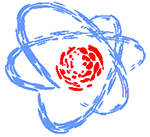Speakers
Description
Summary
RBS studies have shown that the distribution of components in depth is uniform and stoichiometric composition of the compound components is fulfilled. The observed oxygen in RBS spectrum characteristic for the surface region may be associated with a degree of purity of the compound components. Implantation of hydrogen ions H2+ with 70 keV energy and a dose 5х10E15cm-2 shows that a critical dose of beginning of the amorphization is grater than 1х10E15 cm-2 and is in satisfactory agreement with the calculated value for such structurally complex crystal. From Raman spectra of the layered GaS crystals it is established that at Hydrogen implantation with doses below 5x10E15cm-2 position of the bands is preserved and intensity of the bands is increased, that is connected with the improvement of the stability of crystal lattice, and at a dose 5x10E15cm-2 is observed decrease in the intensity of bands. It is obtained that photoresponse of sample increased (from 0.66 to 5.3 times) with dose up to 1x10E15 p/cm2 in the wide wavelength range (490nm-900nm). New peaks with maximum at λ=668 nm and λ= 739nm and appeared on the spectrum of irradiated sample. The energy of new levels is 0.58 eV and 0.77 eV. The photorespose started to decrease dramatically with dose (up to 5x10E15 p/cm2) due to the increase in the degree of structural disorder (amorphization). Determination of the critical dose of amorphization beginning allows the use of ion implantation for the creation of quantum dots in layered GaS crystals when at a sub-threshold dose is formed material containing nano-sized crystalline and amorphous regions.

